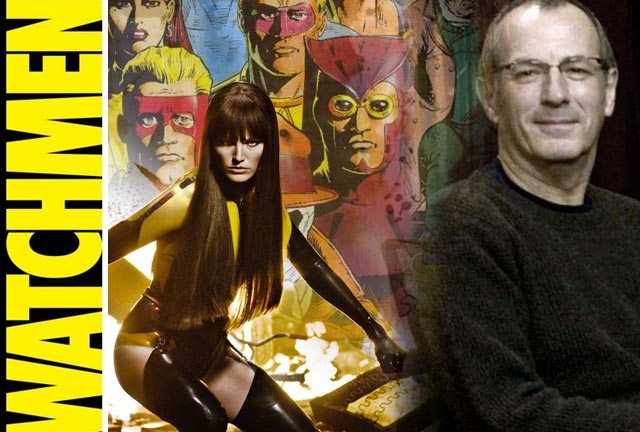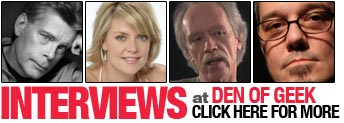Interview: Dave Gibbons talks Watchmen and more…
The co-creator of Watchmen talks about the upcoming movie adaptation and looks back on his career...

Dave Gibbons started out as a comic strip illustrator for DC Thomson and IPC, but came to greater prominence as one of the premiere illustrators at 2000 AD comic in the late 1970s, contributing to strips such as Dan Dare, Rogue Trooper and Harlem Heroes.
His greatest fame was awaiting him in the mid-eighties, when his collaboration with Alan Moore on the Watchmen graphic novel was to lead to both cult and commercial acclaim, and the only Hugo award yet granted to a graphic novel. Gibbons’ working methods and technique are examined along with those of Brian Bolland, Duncan Fegredo and others in the recently-released Studio Space book.
Remaining as busy as ever both as a comic illustrator and writer, Gibbons is looking forward – along with the rest of us – to the release of Zack Snyder’s Watchmen movie adaptation in March of 2009…
How much do you think the Watchmen movie is being faithful to the original? Does fidelity matter?
The most important thing is that the Watchmen movie be a good movie. From what I’ve seen of it, I think it is going to be a good movie, and I think it’s going to be as faithful to the original graphic novel as is possible, given the constraints of a movie and the nature of a graphic novel.
I think that as long as it’s true to the spirit of the comic book, and as long as – in broad strokes – it follows the plot and the characterisations…I don’t think you can ask for every individual detail to be replicated.
There are hardcore fans out there who’ll be satisfied with nothing less than a word-for-word, line-for-line, scene-for-scene recreation of the comic book. I didn’t believe that was ever going to happen. Certainly, from what I’ve seen of the movie, it looks like it’ll be a good movie and very faithful to the comic book. If it isn’t, it won’t be for want of trying. Everybody’s using the graphic novel as their bible, and really doing their best to pay tribute to it, I think.
How do you feel about Alan Moore’s excision from the credits of Watchmen?
Alan’s excision from the credits is entirely at his request. I do respect his right to not have his name on the movie if he doesn’t want to. So does everybody involved with the movie, and documents have been signed that mean his name will not be on it.
I’m happy to have my name on; Alan and I, although we’re friends – and I really hope that throughout all this that we remain friends – we are two different people; we have our own experiences, and we each have a different position.
I suppose I’m sorry that he can’t see his way to having his name on it, but it’s his decision and I respect it. My real feeling is that something which started off so creatively rewarding has actually come to a point where it can’t be by ‘Alan Moore and Dave Gibbons’…in an ideal world, that’s what I would like.Do you prefer working on your own creations rather than established, long-running characters?
There are pros and cons on both. It’s nice sometimes to be given the run of the toy-box, and certainly I’ve had that on what I’ve done on Superman and Green Lantern and some other characters. On the other hand, to create your own stuff from the ground up has its own rewards, and of course in today’s market, where it’s possible to retain rights in your own creations, that’s by far the preferable situation from a business or financial point of view.
Is Watchmen the one you are happy to be remembered for? If not, then which work/strip?
Well, I think that no matter what my wishes are, Watchman is what I’ll be remembered for. It is a huge thing in my CV, and I’m very happy to be remembered for it. As a lifelong fan of the medium, to have had the chance to produce something that has been so commercially and critically successful is a wonderful thing.
Also to know that whenever the histories of comics are written, Watchmen will always have at least a footnote – and probably a chapter – is something that I’m very proud of. I’d like to think that some of my other work would be remembered as well [laughs], but who knows…?
In the 1970s it was strange to see you and Belardinelli both work on Dan Dare – were you keen to abandon his very florid designs to make your own mark on the strip?
I haven’t got Belardinelli’s imagination and he hasn’t got mine [laughs]. The brief was very much to redesign Dan Dare – I’d like to have had a little bit more of a hand in it than I did. I spent a lot of time doing sketches and coming up with the different looks for the characters and the hardware, only to be told that this had already been decided on when the first script was written, and that we were pretty much set.
So yes, I wanted to do it very much my own way. However, it wasn’t completely my way, so it was always a slightly disappointing thing. To my mind, no-one could ever match the sort of level of detail and involvement – and excellence – that Frank Hampson and his studio brought to the character a couple of decades before.How has the shift from the rapid weekly turnover of quickly-produced comics to special projects and one-offs affected your life and work? I mean in terms in of remuneration and quality of work..?
There was a lot to be said for being on a weekly deadline – it certainly concentrates the mind. I’m amazed now, looking back, at the quantity of work I managed to produce…and often the quality. It’s nice not to have to grind stuff out and be dissatisfied, sometimes, with what you’ve had to send in.
On the other hand, it is possible to spend much too long worrying and fiddling around with things, where often the law of diminishing returns applies: for each additional bit of work, you get less and less effect [laughs].
Something like The Originals, which took up two years of my time, did have its own pressures – to sit in a room on your own, being completely responsible for what comes out at the other end, without a writer or an artist or collaborator to discuss things with…it is quite a lonely place to be, with many crises of confidence [laughs]. Fortunately everything turned out all right in the end. So being able to be a little dilettante about things isn’t always the ideal position.
How strong is the writer’s voice within you? Have you ever considered rationalising your visual flair into a purely writing career?
Well, yeah – as the years go on, my desire to write things does get stronger and stronger. I have done such a lot of drawing that my feelings about it are more familiar than the feelings I get from writing. However I do think visually, and I don’t think I’d be entirely happy with only spending my time on the written word.
I’m writing a lot of text for the Watching The Watchmen book, which is going to be coming out later in the year, and I’m really enjoying that – but I keep having to turn away and draw something [laughs].
I think perhaps that to write and draw the same thing is going over something once too often. I may get the desire to do it again, but I’d quite like to spend my time between writing stuff that is either purely text or is for other people to draw, and drawing things that other people have written. I love the sense of collaboration, and that’s one of the things that always attracted me to comics, and which I always look for.
Do you recognise the influence of comics on the production design of films and videogames? Do you feel your work has ever been heavily borrowed-from for work in other media?
This sort of visual cross-fertilisation is inevitable, and I’m sure that for every case where I feel that I’ve been maybe ripped-off, I could probably cite an instance where I’ve been influenced by something I’ve seen in a movie. Movies more than videogames, frankly; I’m not a great player of videogames, and since my son moved out, I don’t really look at them much at all.
I suppose one example of a movie ‘borrowing’ was The Incredibles, which was a great movie that I’ve watched several times and thoroughly enjoy and applaud the craftsmanship of. It kind of has echoes of Watchmen in it – the wall of framed newspapers and stuff like that is obviously…let’s say a homage to what we did in Watchmen.
More than that, there’s one particular image in it which is of Mr. Incredible in his civilian identity being crunched up in a tiny car that looks very close to something I drew in the early 1990s when the Berlin wall came down and a number of European comic artists were asked to contribute a strip about that. I did this thing about a superhero going to Eastern Europe and flooding it with Western consumerism. That did have a scene in it which was of a very bulky man in a collar and tie crammed into a German Trabant car. When I saw that scene in The Incredibles, I thought ‘I wonder if they ever saw that?’. Perhaps they did; I’ve got no proof but I suppose in the end you have to be flattered by people copying your work…How involved are you in the development of new videogames?
I’ve been a little bit involved with an old friend of mine called Charles Cecil of Revolution, who are a respected games publisher – they do adventure games. I’ve been helping him recently to update some resources to convert a game called Broken Sword to some new platforms. It’s largely drawing on my skill as a comic-book illustrator, rather than any great knowledge of videogames. So my involvement, I suppose, is peripheral.
You’re a big supporter of the Bristol Expo – you’re there every year and do the Hypotheticals panel – is it an important event in terms of the UK scene? Is it good for seasoned pros as much as it is for fans and up-and-coming talents?
I like Bristol. I like to drive down there and it’s a nice weekend away. I get to meet all my chums, I get to talk too much and stay up far too late in the bar. I do like to give something back to it, if that doesn’t sound too worthy, and Hypotheticals is a lot of fun. I know a lot of people who enjoy it, so I’m likely to be doing that for as long as they ask me.
As far as networking is concerned, I suppose that as an established pro, a seasoned pro, it’s important. It’s nice to get feedback on what you’ve been doing and to hear of other people’s up and coming projects, and nice too to see the real-world enthusiasm for the field that you work in.
You’ve never worked for Marvel – if you had to choose one Marvel character to write or draw, who would it be?
Actually I have done odd things for them – I wrote a four issue Captain America story arc, which was drawn by an artist called Lee Weeks, who’s a friend of mine. I like Captain America as a character. I also drew a Doctor Strange story, which was written by Walt Simonson – again, a pal of mine.
I’ve never quite understood the way that Marvel comics works, although I’m friendly with a lot of people up there, from Joe Quesada on down. I suppose I’ve always been a DC man. It was always their comics that I loved as a kid. I’ve worked with DC for twenty years, so I kind of understand the office politics, the set-up and how their minds work up there.
I’ve got nothing particularly against doing anything for Marvel – it’s just that it’s never particularly presented itself as a real possibility.
Dave Gibbons, thank you very much!
Dave visited the set of Watchmen in December of 2007, and blogged about it at the Warner Bros site.
More Watchmen stuff on Den of Geek

